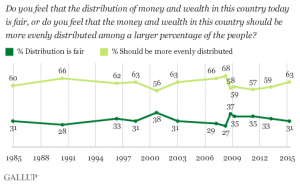The Lack of Government Initiatives Concerning Poverty
As written in the Declaration of Independence, all Americans were endowed inalienable rights upon birth, more specifically, “life, liberty and the pursuit of happiness”. Consequently, the government was created to protect these inalienable rights. Contrasting implications may be revealed if we question whether the inalienable rights of all American people are being protected. Are the rights of the poor being protected too? Some would argue that they are not being protected to the extent that they should be, especially since recent following data from Boston University found that the health gaps between the rich and the poor are widening, which is translating into bigger differences in how long people live.
An article in Time Magazine discusses scientists from Boston University School of Public Health who informed that the richest 1% of US citizens live an average of 10 to 15 years longer than the poorest 1%. To give a broader idea, they also said that since 2001, while people in the middle and high-income groups have augmented on average two years in life expectancy, those with the least income showed no increase in survival.
This may not seem surprising to many, as poverty has always been associated with worse health outcomes. This is because people in lower income groups are not able to afford as much/if any health care and also have a tendency to embrace unhealthy habits, such as poor diets and smoking. For example, the Centers for Disease Control and Prevention reported that due to smoking, families with incomes lower than $12,500 have higher lung cancer incidence than those with family incomes of $50,000 or more. However, in recent years, the Boston University researchers say that several trends have worsened this connection between poverty and health outcomes. Specifically, they say that poverty rates have not only increased but so have obesity and chronic conditions such as diabetes and hypertension, which can cause early death. From 1990 to 2016, the average percentage of obese adults increased from 11.1% to 29.8%. This cycle continues for several reasons, for example, since the poor are the least likely to live until the age required to become eligible for benefits, they are less likely to take advantage of federally mandated health coverage in the form of Medicare.
In the study, the researchers conclude that of the negative feedback loop between income and health, income gaps are likely going to widen, which means that health disparities will follow. The problem is, our own government and many Americans are not likely to support government efforts to equalize, as our book describes, especially programs that redistribute income from the hard working middle class to those who are considered “undeserving.” According to a Gallup Social Series Poll, in 2015 63% of Americans say money and wealth distribution is unfair. The book also states that very few federal government initiatives have been enforced. While the book does acknowledge the reasons why the government has paid little attention to poverty reduction, such as nonexistence political influence of the poor, a political environment that focuses on the middle class, and other cultural notions about poverty, it should be emphasized that poverty affects every member of society, not just the poor themselves. Some negative factors include that inequality stifles growth, increases crime, decreases health, and increases political inequality as a whole. More importantly, one should consider the perspective of viewing poverty as the possibility of what society could be.
Co-author of the aforementioned study, Jacob Bor, warns that “without interventions to decouple income and health, or to reduce inequalities in income, we might see the emergence of a 21st-century health-poverty trap and the further widening and hardening of the socioeconomic inequalities in health”. While it is difficult to state for a fact that wealth leads to better health or vice versa, it is a fact that life expectancy increases as the income distribution ascends. Due to this existing discrepancy, it suggests the lack of government initiatives may indicate that the inalienable rights of the poor are not being protected. If trends continue, the gap will only widen, and the inequality will worsen. What can the government do to give these people the life they were endowed? Their liberty? Will the poor ever have the right pursue their own happiness?
http://time.com/4729816/income-inequality-health-longevity/
https://www.ncbi.nlm.nih.gov/pmc/articles/PMC4866586/
https://www.cdc.gov/tobacco/disparities/low-ses/index.htm
http://www.informit.com/articles/article.aspx?p=1353372&seqNum=4
http://www.globalissues.org/article/26/poverty-facts-and-stats
http://www.bbc.com/news/world-us-canada-41930107
